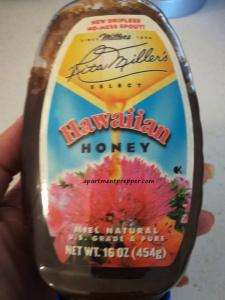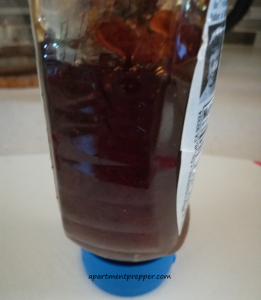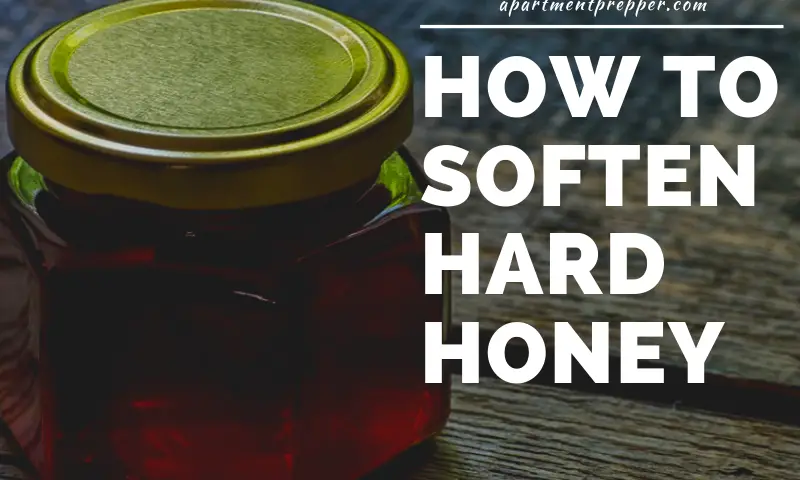This post is by Bernie Carr, apartmentprepper.com
Honey is a staple for food storage as it has a lot of uses and lasts for a very long time. In fact, jars of honey that were found in Egyptian tombs dating back 3,000 years were still edible. Of course, a lot depends on the quality and purity of the honey you have stored.
Years ago, before I learned about storing and using honey, I found a jar of honey in the pantry that had hardened and I threw it away. Now I know it’s actually a good sign, and very easily remedied.
Why does honey crystallize?
A few factors contribute to the rate that honey crystallizes.
Temperature
Honey will harden when stored at 50 degrees or below.
The type of honey
Real raw honey crystallizes, while processed honey will not.
Honey is comprised of glucose and fructose. The more glucose the variety of honey contains, the faster it will crystallize. According to Wired.com, maple, tupelo and blackberry honeys will crystallize slowly, while alfalfa and clover honeys crystallize fast.
Pollen
The amount of pollen in the honey also contributes to crystallization. When there is pollen in the honey, it will crystallize faster. Manufacturers filter out the pollen to prevent crystallization since many buyers mistakenly think that hardened honey has gone bad. Unfortunately, removing the pollen also removes traces of the type of bees that produced the honey, as well as the source the honey your are buying.
So what do you do if your stored honey has hardened?
Storage
If you don’t want your honey to harden in your cupboard, store it in a warmer area. At around 70 degrees, it will not crystallize as quickly.
Hot water
Run your tap water to the maximum heat, and fill a bowl with hot water. Or, warm up some water in a pan on medium heat until the water reaches 140 degrees. Do not boil. Boiling will cause the honey to lose nutrients and possibly warp your container if it’s stored in plastic.
Place your jar of honey in the hot water for about 5-10 minutes. It will start to soften.
Microwave
I don’t prefer the microwave method but some cooks report that it does work.
- Microwaving honey may also kill any beneficial properties.
- Only use the microwave to soften your honey if your honey is in a glass jar. Otherwise, microwaving will cause the plastic container to warp, and potentially leak chemicals into your honey.
- Microwaving will heat the honey unevenly so some portions may burn your tongue if you consume it right after microwaving.
To soften honey using this method, microwave the glass container of honey at 50% power for one minute.
I recently softened some Hawaiian honey I’ve stored since 2010 and I had good results with the hot water method.
1. The honey has crystallized on the top part of the jar. It had also hardened in the nozzle area so I was unable to get any honey out of jar.

2. After soaking the jar for 10 minutes in 140 degree water, the honey has softened enough and I was able to squeeze out the honey.

How do you prefer to soften your stored honey? Please share in the comments.
About the author:
Bernie Carr is the founder of Apartment Prepper. She has written several books including the best-selling Prepper’s Pocket Guide, Jake and Miller’s Big Adventure, The Penny-Pinching Prepper and How to Prepare for Most Emergencies on a $50 a Month Budget. Her work appears in sites such as the Allstate Blog and Clark.com, as well as print magazines such as Backwoods Survival Guide and Prepper Survival Guide. She has been featured in national publications such as Fox Business and Popular Mechanics. Learn more about Bernie here.

Image by Evaldas Daugintis from Pixabay


thank you for the information. And it shows a good reason to buy and store honey in glass jars. I do not like to heat up plastic containers that have food items in them. And not to store your honey in the refrigerator.
Good reminder about not storing honey in the refrigerator. Thanks for the comment.